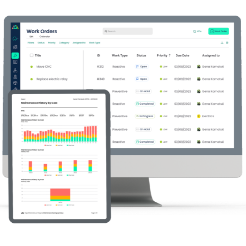
Your Maintenance Processes Aren't Scalable Without a Modern CMMS: Here’s Why
Many organizations struggle with scaling maintenance operations, mainly because some don’t know where to begin, while others don’t realize how important it is to do so. The reality is that as companies grow, with increased asset counts, expanded facilities, or more complex operations, maintenance teams often struggle to keep up without adjusting to these changes. In a growing company, it’s not just about doing more work; it’s about doing more work efficiently, consistently, and predictably across a broader scope.
Too often, organizations attempt to scale using the same methods that worked when they were smaller, such as spreadsheets, paper checklists, whiteboards, or outdated legacy systems. These tools may have been practical when assets were scarce and the team was small. Unfortunately, these approaches lack the needed structure, visibility, and automation necessary to manage large-scale operations. The result of failing to scale up is the creation of bottlenecks, delayed repairs, unplanned downtime, and overwhelmed technicians. A 2022 report by Maintenance.org found that poor coordination and reactive maintenance remain the top obstacles to operational reliability, even as companies invest more in physical infrastructure.
To overcome these problems, a new kind of foundation is required to scale maintenance effectively. More precisely, it’s a digital system built on repeatable processes, centralized coordination, and data-driven decision-making. The solution is a modern CMMS (Computerized Maintenance Management System). A CMMS is more than just software; it’s a critical tool that provides the infrastructure for scaling operations without increasing complexity or risk. It also helps teams shift from a reactive to a preventive approach, from a fragmented to a streamlined process, and from relying on guesswork to gaining insight.
This article examines why maintenance operations frequently fail to scale and how a modern CMMS offers the structure, visibility, and control necessary to support sustainable growth. It focuses on the essential role a CMMS plays in enabling standardized, data-driven, and coordinated maintenance practices as organizations expand.

What it Means to Scale Maintenance Operations
As suggested previously, scaling maintenance isn’t just about managing more work; it’s about doing it without sacrificing reliability, safety, or efficiency. Effective scalability enables maintenance teams to manage a greater number of assets, larger facilities, and increasing volumes of work orders without falling behind or compromising performance and safety. In other words, it involves an organization growing in a way that is sustainable and aligned with its broader operational goals. To achieve these objectives, adjustments include increasing preventive maintenance coverage, enhancing asset uptime, and managing multiple teams across various locations, while maintaining consistency and control.
A misconception held about scaling is that it simply involves adding more personnel or resources. However, these alone do not guarantee the sustainability, consistency, and efficiency that should be a part of effective scaling. Without the right systems in place, adding more people to a flawed process will only magnify inefficiencies. Scaling maintenance requires repeatable workflows, centralized oversight, and real-time visibility into what’s happening on the ground. A modern CMMS provides the digital foundation to support this kind of growth by allowing teams to move beyond troubleshooting and toward long-term operational excellence.
The Limits of Manual and Legacy Systems
When we refer to manual methods, we mean using tools such as spreadsheets, whiteboards, or pen-and-paper logs for managing maintenance. As suggested previously, these may be effective when maintenance operations are small, but they quickly become liabilities as an organization’s demands increase. This is because they lack real-time visibility, are prone to human error, and often lead to duplicated or missed work. Legacy software systems can also be problematic because many of them lack integration capabilities, mobile access, or the flexibility to support multiple sites and growing asset lists. As a company’s operations expand, so do the complexities of coordinating tasks, managing inventory, and tracking performance. Simply put, manual tools can’t keep up.
When teams rely on outdated systems, maintenance becomes a reactive rather than a proactive process. Technicians spend more time searching for information than solving problems, and managers struggle to make informed decisions without trustworthy data. This reactive cycle leads to higher downtime, increased costs, and frustrated staff. Without a centralized, digital platform like a modern CMMS, organizations cannot standardize their processes or scale operations effectively, resulting in chaotic growth rather than strategic growth.
Why Standardization is Essential—and Hard Without a CMMS
Standardization is the cornerstone of scalable maintenance. As teams grow and assets multiply, consistent procedures are what ensure that maintenance tasks are completed the same way, regardless of who performs them or where they’re done. This includes standard operating procedures (SOPs), preventive maintenance schedules, safety checklists, and reporting protocols. Without standardization, technicians may approach tasks in different ways. This can result in inconsistent outcomes, safety risks, and difficulty identifying performance trends.
A modern CMMS enables standardization by providing a centralized platform to document, store, and enforce procedures throughout the organization. The system allows maintenance managers to create and assign recurring tasks with predefined steps, attach reference materials, and set completion expectations. Over time, this creates a routine of repeatable, measurable practices that reduce variability and improve accountability. Without a CMMS, maintaining consistency across growing teams or multiple sites becomes nearly impossible. More to the point, scaling without consistency is a recipe for failure.
Data-Driven Decisions: The Cornerstone of Scalable Maintenance
As maintenance operations grow, decisions can no longer be based on the fly, gut feelings, or anecdotal evidence. Scaling requires a precise understanding of what works, what doesn't, and where to focus resources for the most significant impact. A modern CMMS provides real-time data on key metrics such as mean time to repair (MTTR), mean time between failures (MTBF), preventive maintenance compliance, asset downtime, and technician productivity. With this data, maintenance leaders can make informed decisions to optimize schedules, justify budgets, and identify chronic issues well before they become costly breakdowns.
Without centralized, accurate data, teams are forced to operate blindly, making it nearly impossible to scale efficiently. A CMMS collects and organizes this data, turning it into actionable insights through dashboards and reports. This valuable information enables organizations to transition from a reactive to a proactive strategy, allocate resources more effectively, and continually improve performance. In a scalable maintenance environment, data rules.
Task and Resource Coordination at Scale
As maintenance operations grow, so does the complexity of scheduling work orders, allocating technicians, and managing priorities across assets, teams, and locations. Without a centralized system, this coordination is not only challenging, but it can also become chaotic. Without efficient scaling, work is duplicated or missed, technicians are under- or over-utilized, and critical tasks fall through the cracks. This not only impacts asset reliability but also affects team morale, as skilled workers spend more time chasing information than completing meaningful work.
A modern CMMS streamlines task and resource coordination by centralizing scheduling, automating assignments based on availability and skillsets, and providing real-time updates to everyone involved. The software ensures that the right technician is assigned to the right job at the right time, with all necessary information and parts readily available at their fingertips. As organizations scale, this kind of coordination is crucial because it helps teams stay productive, reduce response times, and maintain control over an increasingly complex operation.
Inventory and Parts Management: Hidden Bottlenecks
Inventory issues are one of the most overlooked barriers to scaling maintenance. As asset counts increase and work orders multiply, the demand for spare parts, tools, and consumables also grows. Without proper inventory management, teams often face delays due to missing or misplaced parts, as well as long waits for replacements. The resulting delays turn what should be routine maintenance into prolonged and avoidable downtime. Relying on manual logs or siloed spreadsheets makes it nearly impossible to track stock levels in real time or anticipate shortages before they disrupt operations.
A modern CMMS addresses this problem by integrating inventory management directly into maintenance workflows. It tracks parts usage by asset type, triggers automated reorder alerts based on minimum stock levels, and allows teams to locate and reserve parts as they schedule work orders. This invaluable capability not only prevents delays but also helps optimize purchasing and reduce excess inventory. As the maintenance functions scale, so must inventory control. In this way, a CMMS can prevent this often neglected form of bottleneck.
Compliance and Documentation at Scale
As maintenance operations scale, so do regulatory requirements, safety standards, and audit expectations. Whether it's OSHA compliance, ISO certification, or internal quality controls, organizations must maintain detailed records of inspections, repairs, and preventive maintenance activities to ensure compliance. Managing this documentation manually is not only inefficient, but it also places organizations at risk for safety concerns, regulatory violations, and related fines. These risks are even greater when an organization is spread across multiple sites or teams.
A modern CMMS streamlines compliance by automatically documenting every work order, inspection, and part replacement with timestamps, technician details, and asset history. It creates a centralized, searchable digital record that can be accessed instantly for audits or performance reviews. There is no longer a need to hunt down relevant documentation or collate it. A CMMS ensures that as operations grow, compliance remains reliable, verifiable, and easy to manage.
Supporting Multi-Site or Multi-Team Operations
Scaling maintenance often involves expanding across multiple facilities, regions, or business units. Under these circumstances, scaling must consider that each facility comes with its assets, teams, and operational nuances. In the absence of a centralized system, maintenance processes quickly become fragmented, with each site developing its workflows, tracking methods, and priorities. These factors create silos, making cross-site reporting difficult and preventing leadership from gaining a clear picture of overall maintenance performance.
A modern CMMS unifies multi-site operations by providing a single platform where all teams can work from shared standards, access real-time data, and coordinate seamlessly. Managers can compare performance across locations, allocate resources strategically, and consistently implement best practices. For companies with distributed assets or mobile teams, a centralized approach is essential for maintaining efficiency, visibility, and control, regardless of the organization's size or geographical dispersion.
Conclusion
In this article, we’ve learned that scaling maintenance is about more than doing more work or expanding personnel; it’s about doing things smarter, faster, and more consistently across growing operations. Without a modern CMMS, organizations face mounting inefficiencies, inconsistent procedures, and blind spots that ultimately interfere with growth. From standardizing workflows to enabling real-time coordination, data-driven decisions, and multi-site visibility, a CMMS provides the necessary structure and intelligence needed to support scalable, high-performance maintenance.
TABLE OF CONTENTS
Keep Reading
By 2026, CMMS platforms will no longer be the limiting factor in maintenance performance. ...
30 Dec 2025
Spare parts management within maintenance can make the difference between a problem-free ...
16 Dec 2025
Every maintenance team eventually faces the same question: When should we repair, and when ...
12 Dec 2025
Enterprise Asset Management (EAM) software has become a cornerstone for organizations aiming ...
12 Dec 2025
Unexpected equipment breakdowns can disrupt operations, increase repair costs, and reduce ...
11 Dec 2025
Businesses are always looking for ways to improve efficiencies, reduce costs, and improve ...
9 Dec 2025
The longest U.S. federal government shutdown to date lasted 43 days, beginning on October 1, ...
5 Dec 2025
Every maintenance professional faces it sooner or later — that critical time when an aging ...
18 Nov 2025
The term 'best' is often used loosely, without a clear understanding of its context or ...
14 Nov 2025
In the not too distant past, maintenance strategies have been defined by reaction—fixing ...
13 Nov 2025
Tax season is the time of year that often sends a ripple of anxiety through many of us. The ...
11 Nov 2025
Selecting a Computerized Maintenance Management System (CMMS) can, at first glance, be an ...
4 Nov 2025
In healthcare facilities, equipment uptime involves more than achieving operational ...
31 Oct 2025
Companies are subject to economic ups and downs, also known as economic volatility. Today, ...
30 Oct 2025
Maintenance challenges are a constant struggle, with unplanned downtime costing manufacturers ...
27 Oct 2025
Last winter, a maintenance technician at a U.S. paper mill ignored a predictive alert that ...
10 Oct 2025
Many organizations proudly say they “have a CMMS,” but ownership alone doesn’t equal ...
9 Oct 2025
Every maintenance team is under pressure to do more with less. Unplanned downtime is often ...
7 Oct 2025
The implementation of simple, yet powerfully effective, checklists has repeatedly ...
3 Oct 2025
In manufacturing, every second counts. When production stops, whether due to scheduled ...
2 Oct 2025






